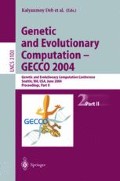Abstract
Topology and Weight Evolving Artificial Neural Networks (TWEANNs) have been shown to be powerful in nonlinear optimization tasks such as double pole-balancing. However, if the input, output, or network structures are high dimensional, the search space may be too large to search efficiently. If the symmetries inherent in many large domains were correctly identified and used to break the problem down into simpler sub-problems (to be solved in parallel), evolution could proceed more efficiently, spending less time solving the same sub-problems more than once. In this paper, a coevolutionary modular neuroevolution method, Modular NeuroEvolution of Augmenting Topologies (Modular NEAT), is developed that automatically performs this decomposition during evolution. By reusing neural substructures in a scalable board game domain, modular solution topologies arise, making evolutionary search more efficient.
Access this chapter
Tax calculation will be finalised at checkout
Purchases are for personal use only
Preview
Unable to display preview. Download preview PDF.
References
Stanley, K.O., Miikkulainen, R.: Evolving neural networks through augmenting topologies. Evolutionary Computation 10, 99–127 (2002)
Stanley, K.O., Miikkulainen, R.: A taxonomy for artificial embryogeny. Artificial Life 9, 93–130 (2003)
Hart, W.E., Belew, R.K.: The role of development in genetic algorithms. Technical Report CS94-394, University of California, San Diego, CA (1994)
Bongard, J.C.: Evolving modular genetic regulatory networks. In: Proc. of CEC 2002, pp. 1872–1877. IEEE Press, Los Alamitos (2002)
Wagner, G., Altenberg, L.: Complex adaptations and the evolution of evolvability. Evolution 50, 967–976 (1996)
Futuyma, D.J.: Evolutionary biology. Sinauer (Sunderland, MA)
Gruau, F., Whitley, D., Pyeatt, L.: A comparison between cellular encoding and direct encoding for genetic neural networks. In: Koza, J.R., Goldberg, D.E., Fogel, D.B., Riolo, R.L. (eds.) Genetic Programming 1996: Proceedings of the First Annual Conference, Stanford University, CA, USA, pp. 81–89. MIT Press, Cambridge (1996)
Nolfi, S.: Using emergent modularity to develop control systems for mobile robots. Adaptive Behavior 5, 343–363 (1997)
Calabretta, R., Nolfi, S., Parisi, D., Wagner, G.P.: A case study of the evolution of modularity: Towards a bridge between evolutionary biology, artificial life, neuro- and cognitive science. In: Adami, C., Belew, R., Kitano, H., Taylor, C. (eds.) Proceedings of Artificial Life VI, MIT Press, Cambridge (1998)
Watson, R.A., Pollack, J.B.: Symbiotic composition and evolvability. In: Kelemen, J., Sosík, P. (eds.) ECAL 2001. LNCS (LNAI), vol. 2159, pp. 480–490. Springer, Heidelberg (2001)
de Jong, E.D.: Representation development from pareto-coevolution. In: Proc. of GECCO 2003, Morgan Kaufmann, San Francisco (2003)
Bentley, P.J., Kumar, S.: Three ways to grow designs: A comparison of embryogenies for an evolutionary design problem. In: Proc. of GECCO 1999, pp. 35–43 (1999)
Stanley, K.O., Miikkulainen, R.: Competitive coevolution through evolutionary complexification. Journal of Artificial Intelligence Research 21 (2004)
Radcliffe, N.J.: Genetic set recombination and its application to neural network topology optimization. Neural computing and applications 1, 67–90 (1993)
Goldberg, D.E., Richardson, J.: Genetic algorithms with sharing for multimodal function optimization, pp. 148–154
Yao, X.: Evolving artificial neural networks. Proc. IEEE 87, 1423–1447 (1999)
Calabretta, R., Nolfi, S., Parisi, D., Wagner, G.P.: Duplication of modules facilitates the evolution of functional specialization. Artificial Life 6, 69–84 (2000)
Moriarty, D.E.: Symbiotic Evolution of Neural Networks in Sequential Decision Tasks. PhD thesis, The University of Texas at Austin (1997)
Kvasnička, V., Pospíchal, J.: Emergence of modularity in genotype-phenotype mappings. Artificial Life 8 (2002)
Gruau, F.: Automatic definition of modular neural networks. Adaptive Behavior 3, 151–184 (1994)
Belew, R.K., Kammeyer, T.E.: Evolving aesthetic sorting networks using developmental grammars. In: Forrest, S. (ed.) Proc. of the 5th International Conference on Genetic Algorithms, Morgan Kaufmann, San Francisco (1993)
Author information
Authors and Affiliations
Editor information
Editors and Affiliations
Rights and permissions
Copyright information
© 2004 Springer-Verlag Berlin Heidelberg
About this paper
Cite this paper
Reisinger, J., Stanley, K.O., Miikkulainen, R. (2004). Evolving Reusable Neural Modules. In: Deb, K. (eds) Genetic and Evolutionary Computation – GECCO 2004. GECCO 2004. Lecture Notes in Computer Science, vol 3103. Springer, Berlin, Heidelberg. https://doi.org/10.1007/978-3-540-24855-2_7
Download citation
DOI: https://doi.org/10.1007/978-3-540-24855-2_7
Publisher Name: Springer, Berlin, Heidelberg
Print ISBN: 978-3-540-22343-6
Online ISBN: 978-3-540-24855-2
eBook Packages: Springer Book Archive

